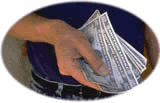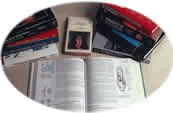
Grades 9-12

Don't have an account yet? Sign up for free
Don't have an account yet? Sign up for free

Students will be rewarded for positive behavior and performance in class through a monetary incentive program. Classroom cash will be earned on a daily basis for such things as attendance, punctuality, and assignment completion. Conversely, students will be charged for such things as absences, tardies, hallway passes, behavior, and missing assignments. Classroom cash can be redeemed for specific priviledges. For example, such things as where they sit, hallway passes, and credit toward assignments. In the end, student behavior and performance improve as they strive to take advantage of this incentive program.
 How would you like to be able to buy the right to sit wherever you want to sit in economics class? Have you ever wondered what it would be like to earn the money to pay a teacher for an assignment instead of having to do the work yourself? If you play your cards right you may be able to do just that. You will participate in a classroom incentive program that will pay you for doing what is asked of you in class on a daily basis. Attendance, good behavior, and work completion will allow you to spend the classroom cash you will earn on luxuries that you want. Make good choices every day and you will be compensated. In this lesson you will learn how the incentive program affects the personal choices students make in class. You will also analyze how economic incentives can affect behavior.
How would you like to be able to buy the right to sit wherever you want to sit in economics class? Have you ever wondered what it would be like to earn the money to pay a teacher for an assignment instead of having to do the work yourself? If you play your cards right you may be able to do just that. You will participate in a classroom incentive program that will pay you for doing what is asked of you in class on a daily basis. Attendance, good behavior, and work completion will allow you to spend the classroom cash you will earn on luxuries that you want. Make good choices every day and you will be compensated. In this lesson you will learn how the incentive program affects the personal choices students make in class. You will also analyze how economic incentives can affect behavior.
[Note: This lesson is a template for a token economy which provides a simulated economic incentive for appropriate conduct. Economic concepts should be taught by the instructor using this plan in a manner which kids can see tangible results from their actions. It is up to the teacher to adapt specific concepts into a lesson. For example, concepts such as inflation, recession, etc can be simulated with this plan. This plan can be used as a supplement to the normal economics curriculum. Therefore, additional web related resources are not necessary.]
 Economic incentives are the additional rewards or penalties people receive from engaging in more or less of a particular activity. At the start of the program, students will answer the survey below; their responses will give the teacher a good idea of what classroom privileges are important to them, thus helping the teacher to gauge the level of demand for privileges and set prices based on demand. Every class is unique in its makeup, so results may differ from class to class. Obviously, the higher the demand, the more value that should be placed on the specific privilege. These are sample questions; the list may be different based on what you allow in your classroom.
Economic incentives are the additional rewards or penalties people receive from engaging in more or less of a particular activity. At the start of the program, students will answer the survey below; their responses will give the teacher a good idea of what classroom privileges are important to them, thus helping the teacher to gauge the level of demand for privileges and set prices based on demand. Every class is unique in its makeup, so results may differ from class to class. Obviously, the higher the demand, the more value that should be placed on the specific privilege. These are sample questions; the list may be different based on what you allow in your classroom.
Please rank the following classroom privileges. in order of importance to you.
[Note to teacher: It is up to the teacher to determine how records will be kept. Using a large spreadsheet chart that is posted in the classroom and "paying" the student to serve as recorders is one possible way to do so. Another way of doing this is to have each student keep their own spreadsheet to record how they benefited or how they incurred costs each week. This is another opportunity to have the students use their entrepreneurial ability. A contest could be held to see which student can devise the best and most efficient method of data collection. A reward can be "paid" to the winner.
Another thing this teaches is that money is valuable for what it buys, not for any intrinsic value. It might be useful to point this out to the students if they think it is "stupid" to make "play" money.]
Evaluate the following alternative solutions to this problem.
[Note to teacher: The teacher is in control of how much value is assigned to different objectives. For instance, students could earn $2 per day for attendance, $1 for every assignment that is completed, and so on. It is a good idea to give random bonuses for behaviors you want to reward. In turn, negative behaviors such as tardiness should result in a fine. Students might be charged $1 per day for each instance of tardiness. If they are absent, they will not receive any money for that day. Detention or office referral should also cost them a minimum of $2. It is up to the teacher to determine the final dollar amount and the activities that could earn money or result in a loss of money. Determining the cost of other items should be determined based upon the results of the survey.
This is a program that can continue to use throughout the year if you would like to make it a normal part of your classroom management plan. In addition, you may use this program as a tool when introducing concepts from content standards 1 (dealing with limited resources), 8 (dealing with prices sending signals to buyers and sellers), and 19 (unemployment). It is also possible to modify the activity by introducing new elements such as more cash in circulation or limits on what can be purchased. Such modifications can be helpful in introducing the concepts of inflation and scarcity.]
The results of the survey should show your class which privilege is the most important and which is the least important. Based on these results, your students can now determine ways in which to earn "money" that can be spent toward the purchase of the above privileges. Each task/activity needs to be assigned a value so you and your teacher can keep track of how much each person in class has earned. For example, handing in an assignment on time may be worth more than showing up to class on time. A list of ideas has been supplied below to get your students started.
Now that they have come up with ways to earn money that can be used to purchase the incentives, you need to decide what to use for cash. As a class, decide on a form of currency to use with the Classroom cash Program. A list of possibilities has been provided below.
Finally, before implementing the Classroom cash Program your students must decide if there will be fines or penalties that can be charged during its use. For example, if students hand in homework late or are tardy to class, should they be penalized for their actions and if so how much?
You should now be ready to begin using the classroom cash plan in your own classroom. However, before starting, think about what makes things valuable to you while answering the following questions:
While participating in the Classroom Cash Program, your students have experienced on a daily basis how an incentive can affect personal behavior. Have the students list as many economic concepts that were covered by this program as they can think of. Inform them to be prepared to share this with the rest of the class.
This program will provide opportunities for daily informal assessment. The incentives should improve the behavior and performance of most students in your classroom. The following questions can give you a chance for feedback.
 What do the students think of this activity? They will pretend they are in charge of asking the organization which "funds" their program with classroom cash for continued funding. Based on their own experiences with the program, they will write an essay that would explain their point of view. They will need to include a detailed explanation of the program and an analysis of its benefits. Make sure to include supporting visuals such as graphs, charts, and/or spreadsheets.
What do the students think of this activity? They will pretend they are in charge of asking the organization which "funds" their program with classroom cash for continued funding. Based on their own experiences with the program, they will write an essay that would explain their point of view. They will need to include a detailed explanation of the program and an analysis of its benefits. Make sure to include supporting visuals such as graphs, charts, and/or spreadsheets.
OR
Have the students pretend they are the person/s in charge of the organization that "funds" them with classroom cash. They will determine if they will continue or cease funding for the program. Have them write an essay explaining their reasons why. Make sure they include a detailed explanation as to why they made their decision. Students will also need to include any supporting visuals such as graphs, charts, and/or spreadsheets.

Grades 9-12

Grades K-2

Grades K-2, 3-5

Grades 9-12
